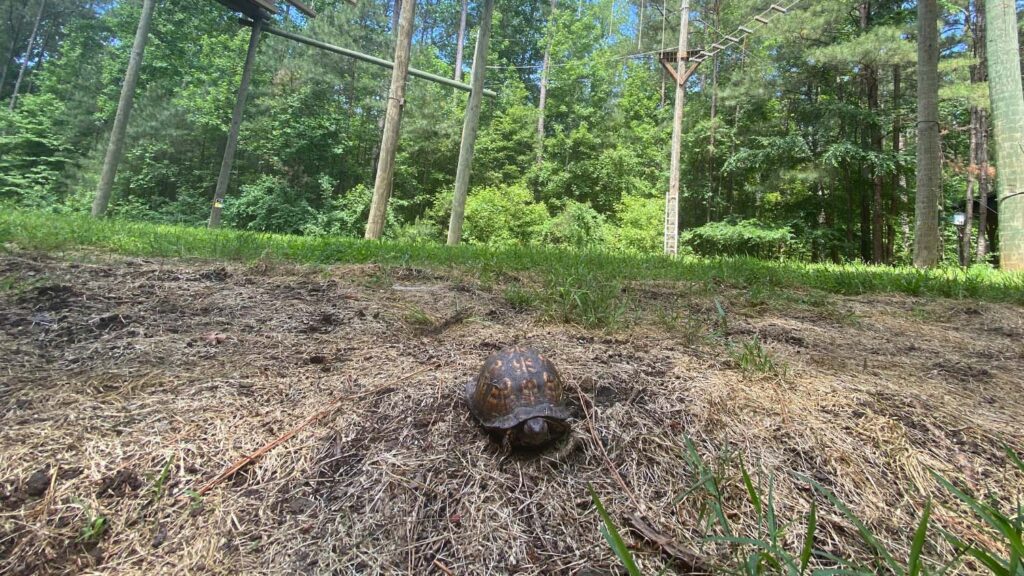Plants and Animals

The management efforts of NC State’s College of Natural Resources over the decades has developed Schenck Forest into a hotspot of biodiversity in the middle of an otherwise urbanizing landscape.
Schenck Forest is home to a variety of forest stand ages and forest types that not only feature native plant species but also provide habitats for a wide range of birds, mammals, amphibians, reptiles and insects.
Common wildlife species at Schenck Forest include summer tanager, pine warbler, indigo bunting, white-tailed deer, Eastern box turtle and Eastern fence lizard. Many observed species are listed below.
Observed Species
Plants
- American beech
- American holly
- Sourwood
- American sycamore
- Arrowwood viburnum
- Atamasco lily
- Autumn-olive
- Thorny olive
- Beaked panic grass
- Bedstraw
- Bigleaf snowbell
- Bitternut hickory
- Blackberry
- Black cherry
- Black walnut
- Black willow
- Blackgum
- Blackhaw viburnum
- Bluegrass
- Boxelder
- Broad beech fern
- Broomsedge
- Butterwort
- Carolina geranium
- Carolina jessamine
- Cherrybark oak
- Chinese lespedeza
- Chinese privet
- Christmas fern
- Common elderberry
- Common greenbrier
- Common persimmon
- Cranefly orchid
- Dandelion
- Devil’s walkingstick
- Dock
- Downy arrowwood
- Eastern redbud
- Eastern redcedar
- Ebony spleenwort
- False nettle
- False Solomon’s seal
- Flowering dogwood
- Forget-me-not
- Fragrant goldenrod
- Goldenrod
- Green-and-gold
- Hawksbeard
- Heartleaf foam flower
- Honeylocust
- Hop-hornbeam
- Hornwort
- Horse sugar
- Ironwood
- Jack-in-the-pulpit
- Japanese honeysuckle
- Japanese stiltgrass
- Jewelweed
- Knotweed
- Kudzu
- Lady slipper
- Little bluestem
- Little brown jug
- Lizard’s tail
- Loblolly pine
- Longleaf pine
- Low panicgrass
- Lyreleaf sage
- Mapleleaf viburnum
- Mayapple
- Mimosa
- Mockernut hickory
- Multiflora rose
- Muscadine grape
- Netted chain fern
- Northern red oak
- Painted buckeye
- Perfoliate belwort
- Pignut hickory
- Poison ivy
- Bear’s claw
- Rabbit tobacco
- Rattlesnake fern
- Red clover
- Red maple
- Red mulberry
- River birch
- Royal paulownia
- Sensitive fern
- Sessile bellwort
- Shrub yellowroot
- Sea myrtle
- Slippery elm
- Small-flowered buttercup
- Snakeroot
- Southern lady fern
- Southern magnolia
- Southern red oak
- Southern sugar maple
- Spicebush
- Spotted/striped wintergreen
- Strawberry bush
- Swamp chestnut oak
- Sweetgum
- Trumpet creeper
- Tulip-poplar
- Umbrella magnolia
- Virginia pine
- Water oak
- Wax myrtle
- White ash
- White clover
- White oak
- White pine
- Comfrey
- Wild onion
- Wild violet
- Willow oak
- Wingstem
- Wintercreeper
- Wood sorrells
- Yellow-flowered leafcup
Herps
- American toad
- Black racer
- Northern cricket frog
- Redbelly snake
- Southern leopard frog
- Two-lined salamander
- White-spotted slimy salamander
- Worm snake
- Yellow-bellied slider
Click here to learn more about amphibians and reptiles of North Carolina.
Mammals
- Eastern cottontail
- Gray squirrel
- Hispid cotton rat
- White-tailed deer
- Coyote
- Fox
- Opossum
- Raccoon
View camera trap images of some animals in the forest.
Insects
- American lady butterfly
- Ant
- Antelope beetle
- Aphid
- Black swallowtail butterfly
- Carpenter bee
- Cicada
- Common whitetail butterfly
- Cranefly
- Cutworm moth
- Eastern tent caterpillar
- Eastern tiger swallowtail butterfly
- Flies
- Katydid
- Monarch butterfly
- Silver spotted skipper
- Stink bug
- Termite
- Thrip
- Yellow jacket
Birds
- American crow
- American goldfinch
- American woodcock
- Barn swallow
- Black vulture
- Black-throated blue warbler
- Blue grosbeak
- Blue jay
- Blue-gray gnatcatcher
- Blue-headed vireo
- Brown creeper
- Brown thrasher
- Brown-headed cowbird
- Brown-headed nuthatch
- Canada goose
- Carolina chickadee
- Carolina wren
- Chimney swift
- Chipping sparrow
- Common grackle
- Double-crested cormorant
- Downy woodpecker
- Eastern bluebird
- Eastern kingbird
- Eastern phoebe
- Eastern towhee
- European starling
- Fish crow
- Great blue heron
- Great crested flycatcher
- Great horned owl
- Hairy woodpecker
- House finch
- Killdeer
- Mallard
- Mourning dove
- Northern cardinal
- Northern flicker
- Northern mockingbird
- Northern parula
- Northern rough-winged swallow
- Northern waterthrush
- Orchard oriole
- Ovenbird
- Pileated woodpecker
- Pine warbler
- Purple martin
- Red-bellied woodpecker
- Red-eyed vireo
- Red-tailed hawk
- Red-winged blackbird
- Rock pigeon
- Ruby-crowned kinglet
- Ruby-throated hummingbird
- Summer tanager
- Tree swallow
- Tufted titmouse
- Turkey vulture
- White-breasted nuthatch
- White-throated sparrow
- Wood thrush
- Yellow-rumped warbler
- Yellow-throated warbler
Total Species: 63
Other
- Carolina mantle slug
- Cherry millipede
- Crawdad
- Earthworm
- Giant American millipede
- Gilled polypore
- Pillbug
- Turkey tail
- Wolf spider